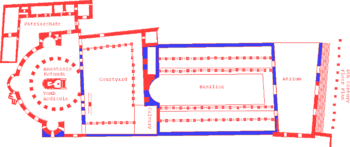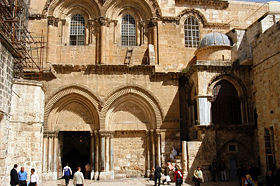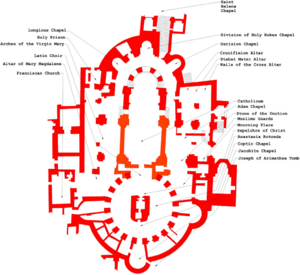Holy Sepulchre
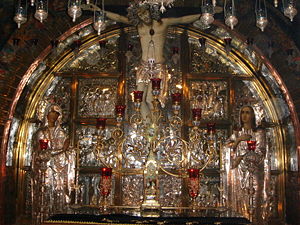
According to the Bible, the Holy Sepulchre refers to the temporary tomb in which Jesus was reportedly buried following his crucifixion. It is said that this burial chamber, supplied by Joseph of Arimathea, was located near the place of Jesus' execution (John 19: 41-42). Following Jesus' death, the tomb was venerated by the early Christians; however, the destruction of Temple of Jerusalem in 70 C.E. caused it to fall into neglect. A pagan temple to Aphrodite was subsequently built on the site during the Roman reconstruction of the city in 135 C.E. In the fourth century, Emperor Constantine I (c. 280-337) allegedly sent his mother, Saint Helena, to find Jesus' burial place in Jerusalem, as well as the so-called "True Cross" upon which Jesus was crucified.[1] It is said that she located both of these sacred relics. Emperor Constantine then ordered a grand church to be built at the site of the tomb, which is now known as the Church of the Holy Sepulchre (the Eastern Orthodox Christians call it the Church of the Anastasis—Resurrection). Ever since this time, and despite being rebuilt several times, the church has been an important pilgrimage destination for Christians. In fact, it is widely considered to be the holiest Christian site in the world.[2]
The ground on which the Church of the Holy Sepulchre rests is venerated by most Christians as Golgotha itself,[2] where the New Testament describes Jesus as being crucified.[3] The church encompasses both Jesus' tomb and the site of Calvary, as both spots were in close proximity. When first built in 335 C.E., the Church of the Holy Sepulchre was located outside Jerusalem's city walls, but due to the city's expansion, it is now found within the walled Old City of Jerusalem today. From the time of its original construction and through its numerous renovations, the Church of the Holy Sepulchre has been venerated by most Christians as the authentic site of Jesus' crucifixion and burial.
History
The ancient church historian Eusebius of Caesarea (c. 275–339) mentions the Holy Sepulchre in his Life of Constantine, saying that this original site of veneration for the Christian community in Jerusalem had been covered with dirt and a temple of Aphrodite (Venus) had been built on top. Although Eusebius does not say as much, this would probably have been done as part of Hadrian's reconstruction of Jerusalem as Aelia Capitolina in 135 C.E., following the Bar Kokhba's revolt (132–135 C.E.). Emperor Constantine I ordered that the site be uncovered in 325-326 C.E., and instructed Saint Macarius, Bishop of Jerusalem, to build a church there.
The original structure was completed by 333-35 C.E., and was said to be an impressive building. The Pilgrim of Bordeaux was able to write the following description of what he saw at the site in 333 C.E.:
There, at present, by the command of the Emperor Constantine, has been built a basilica, that is to say, a church of wondrous beauty…[4]
Constantine's church was built beside the excavated hill of the Crucifixion, and was actually three connected churches built over the three different holy sites, including a great basilica (the Martyrium visited by the nun Egeria in the 380s), an enclosed colonnaded atrium (the Triportico) built around the traditional Rock of Calvary, and a rotunda, called the Anastasis ("Resurrection"), which contained the remains of the cave that Helena and Macarius had identified as the burial site of Jesus. The surrounding rock was cut away, and the Tomb was encased in a structure called the the Kouvouklion (Greek: Cubicle) or Edicule (Latin aediculum, small building) in the center of the rotunda. The dome of the rotunda was completed by the end of the fourth century.
The building was damaged by fire in 614 C.E., when the Persians under Khosrau II invaded Jerusalem and are said to have captured the "True Cross." In 630 C.E., Emperor Heraclius marched into Jerusalem and allegedly restored the True Cross to the rebuilt Church of the Holy Sepulchre. Under the Muslims, the site had remained a Christian church. The early Muslim rulers protected the city's Christian sites, prohibiting their destruction or their use as living quarters, but after a riot in 966 C.E., when the doors and roof were burnt, the original building was completely destroyed on October 18, 1009, by the "mad" Fatimid caliph Al-Hakim bi-Amr Allah, who hacked out the Church's foundations down to the bedrock. The Edicule and the east and west walls and the roof of the cut-rock tomb it encased were destroyed or damaged (accounts vary), but the north and south walls were likely protected by rubble from further damage.
European reaction was far-reaching and often irrational. For example, the Clunaic monk Raoul Glaber blamed the Jews, with the result that "Jews were expelled from Limoges and other French towns."[5] Ultimately, this destruction provided an impetus to the later Crusades.
A small chapel was subsequently erected on the site by Constantine IX Monomachos, beginning in 1048 C.E., under stringent conditions imposed by the caliphate. The rebuilt sites were taken by the knights of the First Crusade on July 15, 1099 C.E. The First Crusade was envisioned as an armed pilgrimage, and no crusader could consider his journey complete unless he had prayed as a pilgrim at the Holy Sepulchre. Crusader chief Godfrey of Bouillon, who became the first crusader monarch of Jerusalem, decided not to use the title "king" during his lifetime, and declared himself Advocatus Sancti Sepulchri, "Protector (or Defender) of the Holy Sepulchre." The chronicler William of Tyre reports on the reconstruction of the Holy Sepulchre in the mid-twelfth century C.E., when the crusaders began to renovate the church in a Romanesque style and added a bell tower. These renovations unified the holy sites and were completed during the reign of Queen Melisende in 1149 C.E. The church became the seat of the first Latin Patriarchs, and was also the site of the kingdom's scriptorium. The church was lost to Saladin, along with the rest of the city, in 1187 C.E., although the treaty established after the Crusade allowed for Christian pilgrims to visit the site. Emperor Frederick II regained the city and the church by treaty in the thirteenth century C.E., while he himself was under a ban of excommunication, leading to the curious result of the holiest church in Christianity being laid under interdict. Both city and church were captured by the Khwarezmians in 1244 C.E.
The Franciscan friars renovated it further in 1555 C.E., as it had been neglected despite increased numbers of pilgrims. A fire severely damaged the structure again in 1808 C.E., causing the dome of the Rotonda to collapse and smashing the Edicule's exterior decoration. The Rotunda and the Edicule's exterior were rebuilt in 1809–1810, by architect Komminos of Mytilene in the then current Ottoman Baroque style. The fire did not reach the interior of the Edicule, and the marble decoration of the Tomb dates mainly to the 1555 restoration. The current dome dates from 1870 C.E. Extensive modern renovations began in 1959 C.E., including a restoration of the dome from 1994–1997. The cladding of red marble applied to the Edicule by Komminos has deteriorated badly and is detaching from the underlying structure; since 1947 C.E., it has been held in place with an exterior scaffolding of iron girders installed by the British Mandate. No plans have been agreed upon for its renovation.
Modern arrangement of the church
The entrance to the church is now through a single door in the south transept. This narrow way of access to such a large structure has proven to be hazardous at times. For example, when a fire broke out in 1840 C.E., dozens of pilgrims were trampled to death. In 1999 C.E., the communities agreed to install a new exit door in the church.
Just inside the entrance is the Stone of Anointing, believed to be the spot where Jesus' body was prepared for burial. To the left, or west, is the Rotunda of the Anastasis beneath the larger of the church's two domes, in the center of which is the Edicule ("little house") protecting the tomb itself. Under the status quo the Eastern Orthodox, Roman Catholic, and Armenian Apostolic Churches all have rights to the interior of the tomb, and all three communities celebrate the Divine Liturgy or Mass there daily. It is also used for other ceremonies on special occasions, such as the Holy Saturday ceremony of the Holy Fire celebrated by the Greek Orthodox Patriarch of Jerusalem. To its rear, within a chapel constructed of iron latticework upon a stone base semicircular in plan, lies the altar used by the Coptic Orthodox. Beyond that, to the rear of the Rotunda, is a very rough hewn chapel believed to be the tomb of Joseph of Arimathea, in which the Syriac Orthodox celebrate their Liturgy on Sundays. To the right of the sepulchre on the southeastern side of the Rotunda is the Chapel of the Apparition which is reserved for Roman Catholic use.
On the east side opposite the Rotunda is the Crusader structure housing the main altar of the Church, today the Greek Orthodox catholicon. The second, smaller dome sits directly over the center of the transept crossing of the choir where the compas, an omphalos once thought to be the center of the world, is situated. East of this is a large iconostasis demarcating the Greek Orthodox sanctuary before which is set the Patriarchal throne and a throne for visiting episcopal celebrants. On the south side of the altar via the ambulatory is a stairway climbing to the Chapel of Calvary, or Golgotha, believed to be the site of Jesus' crucifixion and the most lavishly decorated part of the church. The main altar there belongs to the Greek Orthodox, while the Roman Catholics have an altar to the side. Further to the east in the ambulatory are the stairs descending to the Chapel of St. Helena, belonging to the Armenians. From there, another set of stairs leads down to the Roman Catholic Chapel of the Invention of the Holy Cross, believed to be the place where the True Cross was found.
Authenticity
From the time of its original construction in 335 C.E., and through its numerous renovations, the Church of the Holy Sepulchre has been venerated by almost all Christians as the authentic site of Jesus' crucifixion and burial.
Both Eusebius' and Socrates' Scholasticus record that the tomb of Jesus was originally a site of veneration for the Christian community in Jerusalem and its location remembered by that community even when the site was covered by Hadrian's temple. Eusebius in particular notes that the uncovering of the tomb "afforded to all who came to witness the sight, a clear and visible proof of the wonders of which that spot had once been the scene" (Life of Constantine, Chapter XXVIII).
Archaeologist Martin Biddle of Oxford University has theorized that this clear and visible proof might have been a graffito to the effect of "This is the Tomb of Christ," scratched in the rock by Christian pilgrims before the construction of the Roman temple (Biddle, 1999). Similar ancient graffiti are still visible in the Catacombs of Rome, indicating the tombs of especially venerated saints.
In the nineteenth century, a number of scholars disputed the identification of the Church with the actual site of Jesus' crucifixion and burial. They reasoned that the Church was inside the city walls, while early accounts (such as Hebrews 13:12) described these events as outside the walls. On the morning after his arrival in Jerusalem, Charles George Gordon (1833–1885) selected a rock-cut tomb in a cultivated area outside the walls as a more likely site for the burial of Jesus. This site is usually referred to as the Garden Tomb to distinguish it from the Holy Sepulchre, and it is still a popular pilgrimage site for those (usually Protestants) who doubt the authenticity of the tomb and/or do not have permission to hold services in the Church itself.
However, it has since been determined that the site was indeed outside the city walls at the time of the crucifixion. The Jerusalem city walls were expanded by Herod Agrippa in 41–44 C.E., and only then enclosed the site of the Holy Sepulchre, at which time the surrounding garden mentioned in the Bible would have been built up as well. To quote the Israeli scholar Dan Bahat, former City Archaeologist of Jerusalem:
We may not be absolutely certain that the site of the Holy Sepulchre Church is the site of Jesus' burial, but we have no other site that can lay a claim nearly as weighty, and we really have no reason to reject the authenticity of the site (Bahat, 1986).
Contemporary status
Since the renovation of 1555 C.E., control of the church oscillated between the Franciscans and the Orthodox, depending on which community could obtain a favorable decree from the Ottoman government at a particular time, often through outright bribery, and violent clashes were not uncommon. In 1767 C.E., weary of the squabbling, the Ottoman government issued a decree that divided the church among the claimants. This was confirmed in 1852, with another decree that made the arrangement permanent, establishing a status quo of territorial division among the communities.
The primary custodians are the Greek Orthodox, the Armenian Apostolic and Roman Catholic churches. In the nineteenth century, the Coptic Orthodox, the Ethiopian Orthodox and the Syriac Orthodox acquired lesser responsibilities, which included shrines and other structures within and around the building. Times and places of worship for each community are still strictly regulated in common areas.
Establishment of the status quo did not halt the violence, which continues to break out every so often even in modern times.
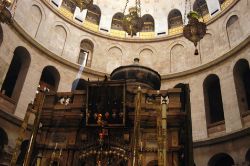
Under the status quo no part of what is designated as common territory may be rearranged without consent from all communities. This often leads to the neglect of badly needed repairs when the communities cannot come to an agreement among themselves about the final shape of a project. Just such a disagreement has delayed the renovation of the edicule ("little house") protecting the tomb, where the need is now dire but where also any change in the structure might result in a change to the status quo disagreeable to one or more of the communities.
A less grave sign of this state of affairs is located on a window ledge over the church's entrance. A wooden ladder was placed there sometime before 1852 C.E., when the status quo defined both the doors and the window ledges as common ground. The ladder remains there to this day, in almost exactly the same position it can be seen to occupy in century-old photographs and engravings.
None of the communities controls the main entrance. In 1192 C.E., Saladin assigned responsibility for it to two neighboring Muslim families. The Joudeh were entrusted with the key, and the Nuseibeh were given the task of keeping the door. This arrangement has persisted into modern times. Twice each day, a Joudeh family member brings the key to the door, which is locked and unlocked by a Nuseibeh.
Notes
- ↑ Socrates Scholasticus, Ecclesiastical History.
- ↑ 2.0 2.1 Sacred Destinations, Church of the Holy Sepulchre, Jerusalem. Retrieved October 7, 2019.
- ↑ New Advent, Holy Sepulchre. Retrieved October 7, 2019.
- ↑ Max Milan, Church of the Holy Sepulchre The Catholic Physicist, August 3, 2017. Retrieved October 7, 2019.
- ↑ Jewish History, 1010 JerusalemM (Eretz Israel) Retrieved October 7, 2019.
ReferencesISBN links support NWE through referral fees
- Cauasnon, Charles. The Church of the Holy Sepulchre Jerusalem. Oxford University Press, 1974. ISBN 978-0197259382
- Bahat, Dan. Does the Holy Sepulchre Church Mark the Burial of Jesus? Biblical Archaeology Review Vol. 12 No. 3 May/June 26–45, 1986.
- Biddle, Martin. The Tomb of Christ. Phoenix Mill Sutton Publishing, 1999. ISBN 0750919264
- Biddle, Martin. The Church of the Holy Sepulchre. New York: Rizzoli, 2000. ISBN 978-0847822829
- Gibson, Shimon and Joan E. Taylor. Beneath the Church of the Holy Sepulchre. London: Palestine Exploration Fund, 1994. ISBN 978-0847822829
- Krüger, Jürgen. Die Grabeskirche zu Jerusalem. Geschichte Gestalt: Bedeutung Regensburg, 2000.
- Willis, Robert. The Architectural History of the Church of the Holy Sepulchre at Jerusalem. Adamant Media Corporation, 2005. ISBN 978-1402153204
External links
All links retrieved July 18, 2024.
- "Divvying up the Most Sacred Place" by Chris Armstrong, Christianity Today, Week of July 29, 2002.
- "Punch-up at tomb of Jesus" by Allyn Fisher-Ilan, The Guardian, September 28, 2004.
- Miracle of the Holy Fire
- Church of the Holy Sepulchre, Jerusalem.
- Holy Sepulchre
Credits
New World Encyclopedia writers and editors rewrote and completed the Wikipedia article in accordance with New World Encyclopedia standards. This article abides by terms of the Creative Commons CC-by-sa 3.0 License (CC-by-sa), which may be used and disseminated with proper attribution. Credit is due under the terms of this license that can reference both the New World Encyclopedia contributors and the selfless volunteer contributors of the Wikimedia Foundation. To cite this article click here for a list of acceptable citing formats.The history of earlier contributions by wikipedians is accessible to researchers here:
The history of this article since it was imported to New World Encyclopedia:
Note: Some restrictions may apply to use of individual images which are separately licensed.
